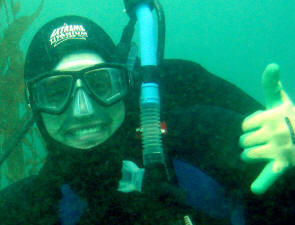Working in the
Zacherl Lab and at CSUF has allowed me to take advantage of some
amazing opportunities. As a master’s student finishing at CSUF,
my work in the Zacherl laboratory in the most general of
contexts is focused on larval ecology and population
connectivity in the subtidal ecosystem of California.
Specifically, as a Zacherl student we exploit a permanent
environmentally influenced calcified structures, such as
statoliths (used by molluscs for equilibrium during locomotion),
by using analytical chemistry techniques, such as inductively
coupled plasma- mass spectrometry (ICP-MS) to discriminate
spatial origins of various molluscs inhabiting the subtidal.
Work done by Dr. Zacherl has shown that seawater temperature
gradients are a factor influencing Kelletia kelletii (Kellet’s
Whelk) to have unique natural tags along at areas of the coast
with different temperatures. I’m testing an area with the same
general temperature, the southern Orange County coast, to
determine if natural tags can be further discriminated spatially
based on differing ambient water metal concentrations of
neighboring marine protected areas (MPAs). My thesis work
directly tests if natural tags of Aplysia californica
(California sea hare) can be discriminated among neighboring
MPAs as well as to determine if unique terrestrial input via
watershed discharge is a factor that influences organisms to
generate unique natural tags among neighboring MPAs. My
master’s thesis will be completed this year.
My thesis work at
CSUF has been exciting and enjoyable for many reasons. CSUF is
proximally located to some of the most beautiful rocky
shorelines in California making it a preferred subtidal
ecosystem to observe. In this ecosystem, I’ve been able to
enrich my experience in scientific SCUBA diving and in
captaining vessels. At CSUF, I’ve completed 176 logged dives
and captained the CSUF ‘Silverside’ (18’ hard bottomed 90hp
zodiac) more than 30 times. As if this were not enough, being a
Zacherl student has allowed me to gain exposure to additional
top-tier institutions in marine biology including UC Santa
Barbara (UCSB) and at SCRIPPS. All of my microchemistry work on
ICP-MS was completed working in collaboration with Georges
Paradis at UCSB which has allowed me to grow tremendous lengths
with my abilities in chemical laboratory techniques. I was also
given the opportunity to take ‘Benthic Ecology’ at SCRIPPS
taught by Dr. Lisa Levin, Dr. Paul Dayton, and Dr. James
Leichter. Lastly, CSUF offers the chance to give back to the
community and recently I was honored to be elected to the
student position of Vice Chair/ Director of Finance for the
College of Natural Sciences and Mathematics (NSM) for the
academic year (06-07). In this position, I review student
proposals for research travel funds (23 have been approved) and
wrote the 2007-2008 budget proposal requesting $27,177.00 (~10%
more than last year). Conducting research in the Zacherl Lab
and taking the master’s program at CSUF has been a great
experience and I cannot imagine a better program to be involved.

